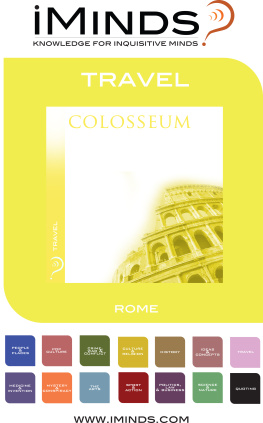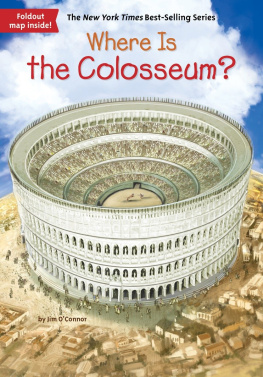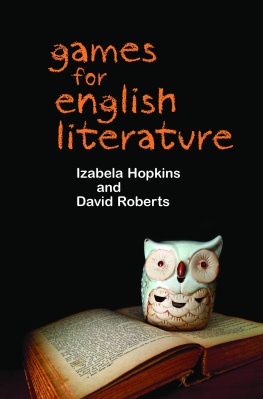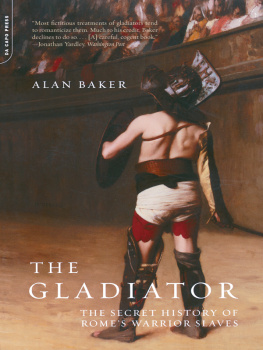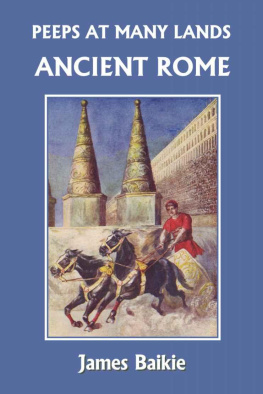A racy and occasionally confrontational book revels in the accretions of detail and myth first-class scholarship and an engagingly demotic style Michael Bywater, Independent
A rollicking good read the authors lively style does full justice to their rumbustious subject matter Guardian
The authors wear their eclectic learning lightly exemplary prose quiet, confident and thorough, this is a fine English book in the best sense of the word The Times
A work of scholarship written with the general reader in mind a pleasure to read Spectator
Supported by an impeccably marshalled but never obtrusive evidential base beautifully written and highly readable Times Higher Education Supplement
The authors educated guesses tend to be more fascinating than the familiar Hollywood portrayal it enriches our appreciation of the Colosseums magnitude and significance Independent on Sunday
This is a volume to take on any journey; it will tell you as much about the perception of ruins as it does about Rome itself BBC History Magazine
This lively book carries the reader painlessly through a complex record of legend and history. A delightful and instructive account G. W. Bowerstock, Institute for Advanced Study, Princeton
A splendid monograph Irish Catholic
Anecdotal, lively and enlightening, Hopkins and Beards book is hugely worthwhile Italian
A small gem of a book the most engaging and entertaining biography of the site available Minerva
This lively, engaging and scholarly book brilliantly conveys the complex significance of this potent monument and of the spectacles that took place within it Royal Academy Magazine
KEITH HOPKINS was Professor of Ancient History at the University of Cambridge and Vice-Provost of Kings College. He was one of the most radical re-interpreters of Roman history and culture of the last fifty years, and author of Conquerors and Slaves (1978), Death and Renewal (1983) and A World Full of Gods (1999). He died in 2004.
MARY BEARD is a Professor of Classics at Cambridge and a Fellow of Newnham College. She is general editor of the Wonders of the World series and has written widely on classical culture and its reception in the contemporary world. Her books include Classical Art from Greece to Rome with J. Henderson (Oxford, 2001), The Roman Triumph (Harvard, 2007), Pompeii: The Life of a Roman Town (Profile, 2008), Its a Dons Life (Profile, 2009), and The Parthenon (Profile, 2010).
WONDERS OF THE WORLD
THE COLOSSEUM
KEITH HOPKINS
AND
MARY BEARD

This updated paperback edition published in 2011
First published in Great Britain in 2005 by
Profile Books Ltd
3A Exmouth House
Pine Street
Exmouth Market
London ECIR OJH
www.profilebooks.com
Copyright Keith Hopkins and Mary Beard, 2005, 2006, 2011
1 3 5 7 9 10 8 6 4 2
Typeset in Caslon by MacGuru Ltd
info@macguru.org.uk
Designed by Peter Campbell
Printed and bound in Great Britain by
Bookmarque Ltd, Croydon, Surrey
The moral right of the authors has been asserted.
All rights reserved. Without limiting the rights under copyright reserved above, no part of this publication may be reproduced, stored or introduced into a retrieval system, or transmitted, in any form or by any means (electronic, mechanical, photocopying, recording or otherwise), without the prior written permission of both the copyright owner and the publisher of this book.
A CIP catalogue record for this book is available from the British Library.
ISBN 978 1 84668 470 8
eISBN 978 1 84765 045 0
CONTENTS
PREFACE
The Colosseum is the most famous, and instantly recognisable, monument to have survived from the classical world. So famous, in fact, that for over seventy years, from 1928 to 2000, a fragment of its distinctive colonnade was displayed on the medals awarded to victorious athletes at the Olympic Games as a symbol of classicism and of the modern Games ancient ancestor.
It was not until the Sydney Games in 2000 that this caused any controversy. British newspapers most of which did not know that the Colosseum had been gracing Olympic medals for more than half a century enjoyed poking fun at the ignorance of the antipodeans who apparently had not grasped the simple fact that the Colosseum was Roman and the Games were Greek. The AustralianGreek press took a loftier tone; as one Greek editor thundered, The Colosseum is a stadium of blood. It has nothing to do with the Olympic ideals of peace and brotherhood.
The International Olympic Committee wriggled slightly, but stood their ground. They had already prevented the organisers of the Games replacing the Colosseum with the profile of the Sydney Opera House, so they presumably had their arguments ready. The design, they insisted, was traditional and it was not, in any case, the Roman Colosseum specifically, but rather a generic Colosseum: As far as we are concerned, its not important if its the Colosseum or the Parthenon. Whats important is that its a stadium.

1. The Sydney Olympic medal (2000) displays the distinctive form of the Colosseum behind the Goddess of Victory and a racing chariot. The Ultimate Ignorance complained one Greek newspaper in Australia.
Unsurprisingly, the Colosseum motif had been replaced by the time the Games went (back) to Greece in 2004. The ponderously titled Committee to Change the Design of the Olympic Medal came up with a new, Greek and much less instantly recognisable design: a figure of Victory flying over the Panathinaikon stadium built in Athens to host the first modern Games in 1896. But the questions that this argument raised about the Colosseum itself still remain. What was its original purpose? (Certainly not the racing signalled by the miniature chariot also depicted on the medal.) How should we now respond to the bloody combats of gladiators that have come to define its image in modern culture? Why is it such a famous monument?
These are just some of the questions we set out to answer in this book.

Figure 1. Plan of the Colosseum.
1
THE COLOSSEUM NOW
COLOSSEUM BY MOONLIGHT
In 1843 the first edition of Murrays Handbook to Central Italy, the essential pocketbook companion for the well-heeled Victorian tourist, enthusiastically recommended a visit to the Colosseum (or the Coliseum as it was then regularly spelled). Many aspects of Rome, it warned, would prove inconvenient or disappointing. The Roman system of timekeeping was simply baffling for the punctual British visitor; its twenty-four-hour clock began an hour and a half after sunset, so times changed with the seasons. The local cuisine left a lot to be desired (A good restaurateur is still one of the desiderata of Rome, moaned the Handbook, somewhat sniffily). Accommodation too could be difficult to find, especially for those with special requirements the invalids who were recommended to search out rooms with a southern aspect, or the nervous persons advised to live in more open and elevated situations. Yet the Colosseum was guaranteed not to disappoint. In fact, it was even more impressive in real life than its reputation might suggest: There is no monument of ancient Rome which artists and engravers have made so familiar to readers of all classes and there is certainly none of which the descriptions and drawings are so far surpassed by the reality. No need then to promote its virtues or guide the visitors response. We shall not attempt to anticipate the feelings of the traveller, the
Next page

